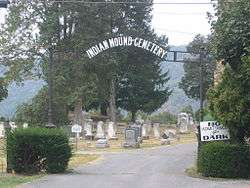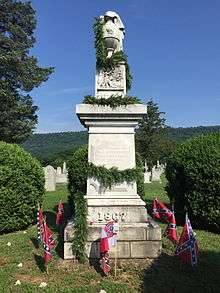Indian Mound Cemetery
|
Indian Mound Cemetery entrance along U.S. Route 50 | |
| Details | |
|---|---|
| Established | 1859 |
| Location | Romney, West Virginia |
| Country | United States |
| Coordinates | 39°20′33″N 78°45′57″W / 39.342599°N 78.765851°WCoordinates: 39°20′33″N 78°45′57″W / 39.342599°N 78.765851°W |
| Type | Private |
| Owned by | Indian Mound Cemetery Association, Inc. |
| Find a Grave | Indian Mound Cemetery |
| The Political Graveyard | Indian Mound Cemetery |
Indian Mound Cemetery is a cemetery located along the Northwestern Turnpike (U.S. Route 50) on a promontory of the "Yellow Banks" overlooking the South Branch Potomac River and Mill Creek Mountain in Romney, West Virginia, United States.[1][2] The cemetery is centered on a Hopewellian mound, known as the Romney Indian Mound.[3][4] Indian Mound Cemetery is also the site of Fort Pearsall, the Confederate Memorial, Parsons Bell Tower, and reinterments from Romney's Old Presbyterian Cemetery. The cemetery is currently owned and maintained by the Indian Mound Cemetery Association, Inc.[1][4]
Indian Mound Cemetery is the burial site of two governors of West Virginia, a United States House Representative, a United States Secretary of the Army, an owner of the Washington Redskins, and descendants of the family of George Washington.[5]
History
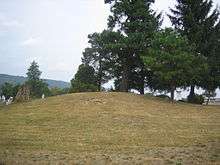
Romney Indian Mound
Physical description
The Romney Indian mound is a burial mound that measures 7 feet (2.1 m) in height and approximately 15 feet (4.6 m) in diameter, according to the site marker. Since this marker was erected, further research indicates the mound has been opened at some point in the past.[1] It is the largest of the remaining mounds discovered in West Virginia's Eastern Panhandle.[1][4] The Romney Indian Mound is representative of thousands of small Middle and Late Woodland burial mounds that occurred throughout much of eastern North America.[3] Throughout its history, the Romney Indian Mound has traditionally been covered in pine trees,[6] of which several remain as of 2010. [7]
Origins
The Romney Indian Mound was constructed at what was once the crossroads of the Shawnee Trail, running north and south, and the east-west Indian Road (later the Northwestern Turnpike and U.S. Route 50) leading to the Allegheny Mountains.[1][4][8]
The original owner of the mound, David Gibson, gave the site to the city of Romney on the condition that the mound would not be disturbed.[1][4] For this reason, the city has never allowed the mound to be excavated.[1][4] The Smithsonian Institution suggests the Romney Indian Mound possibly dates from between 500 and 1000 CE given the ages of similar mounds it excavated in the Eastern Panhandle.[1][4] The mound was likely constructed by peoples of the Hopewell culture, who resided within West Virginia between 500 BC and 1,000 CE.[1][4]
The Romney Indian Mound is perhaps the only accessible mound east of the Allegheny Mountains that has been preserved.[8] This is mostly due in part to both its location high above the flood plain of the South Branch Potomac River and that it was never plowed over.[8]
Indian Mound Cemetery Company and Association
Several years prior to the onset of the American Civil War, Romney's Old Presbyterian Cemetery at Gravel Lane and High Street had become full and the city of Romney sought to procure a larger tract for a new spacious cemetery.[6]
Indian Mound Cemetery was incorporated by an act of the Virginia General Assembly around 1859.[1] The land was conveyed to the Indian Mound Cemetery Company by David Gibson on May 31, 1860.[1] The land conveyed by Gibson had previously been a tract of his nearby Sycamore Dale plantation. The cemetery's original design consisted of two plats: the higher plat around the Romney Indian Mound and the lower plat above Sulphur Spring Run reserved for the burials of African Americans.[1] The latter separated from Indian Mound Cemetery and became known as the Mount Pisgah Benevolence Cemetery, which is currently maintained by the Mount Pisgah United Methodist Church.
On May 22, 1869, a meeting was held at the Hampshire County Courthouse to elect a board of directors of the Indian Mound Cemetery Company.[1] The company operated the cemetery until it was incorporated by the state of West Virginia on August 25, 1925 as the Indian Mound Cemetery Association, Inc.[1] The association has been administered by a self-perpetuating board of directors since 1925.[1]
On October 6, 1925, an additional five acres to the north were purchased by the Indian Mound Cemetery Association, Inc. from Hiram C. and Katie Feidner Cooper.[1][9]
American Civil War
Battle of Romney
Due to its strategic location on a bluff commanding views of the South Branch Potomac River, the Romney Covered Bridge, and the Northwestern Turnpike for half a mile, Indian Mound Cemetery was an important lookout position during the American Civil War.[6][10][11][12] On October 22, 1861, Union Army General Scott ordered General Benjamin Franklin Kelley to concentrate his forces at New Creek (now known as Keyser) and attack and capture Romney.[6] Kelley left New Creek early on the morning of October 27 and the Confederate States Army at Romney began preparations for his arrival.[6][10][11][12] The Confederates planted a twelve-pound rifle cannon and a mountain howitzer in Indian Mound Cemetery ready to fire at the lead of the Union Army column as it emerged from Mechanicsburg Gap in Mill Creek Mountain.[6][10][11][12] The Union forces drove in and advanced to Indian Mound Cemetery where the Confederate forces made a stand and opened fire on the Federals with the twelve-pound rifle cannon and the mountain howitzer.[10][11][12] A severe cannonade took place between the artillery of both the Union and Confederate forces for an hour.[13]
Burials
Also during the American Civil War, Indian Mound Cemetery was used as a burial ground by both Union and Confederate armies.[1] The majority of soldiers killed in the vicinity of Romney were buried in blankets in the cemetery, many whose names are unknown.[1] Captain Richard Ashby, the brother of Confederate General Turner Ashby, was interred with all the honors of war under a giant oak tree on July 4, 1861 in Indian Mound Cemetery shortly after his death at nearby Washington Bottom Farm on July 3 from wounds received in a skirmish on the Baltimore and Ohio Railroad.[5][6][14][15][16] Turner Ashby attended his brother's funeral at Indian Mound Cemetery where his behavior was described in Edward A. Pollard's Southern History of the War as touching:[15][16]
He stood over the grave, took his brother's sword, broke it and threw it into the opening; clasped his hands and looked upward as if in resignation; and then, pressing his lips as if in the bitterness of grief, while a tear rolled down his cheek, he turned without a word, mounted his horse and rode away. Thenceforth his name was a terror to the enemy.[15][16]
Ashby's body was removed from the cemetery to Stonewall Cemetery in Winchester, Virginia in October 1862 where it was reinterred next to Ashby's brother General Turner Ashby.[5][6][14][15][16] Their grave is marked "The Brothers Ashby."[5][14]
Confederate Memorial
The Confederate Memorial was erected by local ladies in honor of Hampshire County's Confederate dead and dedicated in Indian Mound Cemetery on September 26, 1867.[1][17][18] It is considered one of the oldest, if not the first, permanent memorials to Confederate dead in the United States.[1][8][17][18]
Notable interments
- Stephen Ailes (1912–2001), United States Secretary of the Army[19]
- William Armstrong (1782–1865), United States House Representative from Virginia[19][20][21]
- John Rinehart Blue (1905–1965), West Virginia House Delegate from Hampshire County[20][21]
- William C. Clayton (1831–1915), West Virginia State Senator[20]
- Edna Brady Cornwell (1868–1958), First Lady of West Virginia[20]
- John Jacob Cornwell (1867–1953), 15th Governor of West Virginia[1][19][20][21]
- Marshall S. Cornwell (1871–1898), newspaper editor and publisher, poet, and author[20][22]
- William B. Cornwell (1864–1926), railroad and timber executive[20]
- John Collins Covell (1823–1887), Principal of the West Virginia Schools for the Deaf and Blind[20]
- Dr. William Henry Foote (1794–1869), Presbyterian clergyman and historian[23]
- Henry Bell Gilkeson (1850–1921), West Virginia State Senator, West Virginia House of Delegates member, Principal of the West Virginia Schools for the Deaf and Blind, and Superintendent of Hampshire County Schools[20]
- John Jeremiah Jacob (1757–1839), first ordained Methodist minister in Hampshire County[1][19]
- John Jeremiah Jacob (1829–1893), 4th Governor of West Virginia[1][19][21]
- Howard Hille Johnson (1846–1913), founder of and educator at the West Virginia Schools for the Deaf and Blind[20]
- James Sloan Kuykendall (1878–1928), West Virginia House Delegate[20]
- George Preston Marshall (1896–1969), owner and president of the Washington Redskins[19][20]
- Gilbert Proctor Miller (1866–1927), orchardist; founder of Hampshire County's fruit industry
- Alexander W. Monroe (1817–1905), Speaker of the West Virginia House of Delegates and Confederate States Army officer[20]
- George William Washington (1809–1876), gentleman farmer and diarist[5][20]
- Christian Streit White (1839–1917), Clerk of Court for Hampshire County[20]
- John Baker White (1868–1944), Military officer and West Virginia Board of Control member[20]
- Robert White (1876–1935), Prosecuting Attorney for Hampshire County and West Virginia State Senator[20]
- Joshua Soule Zimmerman (1874–1962), West Virginia House Delegate, Hampshire County Prosecuting Attorney, and orchardist[20]
Image gallery
- Iron fence at the entrance
- Entrance gate and Parsons Bell Tower
- Parsons Bell Tower
 Parsons Bell Tower
Parsons Bell Tower- Caretaker's residence
 Romney Indian Mound
Romney Indian Mound Indian Mound Cemetery and U.S. Route 50 in 1942
Indian Mound Cemetery and U.S. Route 50 in 1942- Unknown Confederate graves, decorated for Confederate Memorial Day
 Gravestones at Indian Mound Cemetery
Gravestones at Indian Mound Cemetery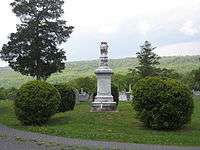 Confederate Memorial
Confederate Memorial Confederate Memorial detail
Confederate Memorial detail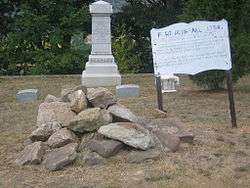 Old Fort Pearsall historical marker
Old Fort Pearsall historical marker- New Fort Pearsall historical marker
- Washington family plot
- Grave of Gilbert Proctor Miller, founder of Hampshire County's fruit industry
- View of Mill Creek Mountain and the South Branch Potomac River
 Harmison family marker
Harmison family marker
See also
- List of Hopewell sites
- List of historic sites in Hampshire County, West Virginia
- Mount Pisgah Benevolence Cemetery
References
- 1 2 3 4 5 6 7 8 9 10 11 12 13 14 15 16 17 18 19 20 21 22 23 Kerns, Wilmer L.; Virginia Pancake; Roberta R. Munske; Hampshire County 250th Anniversary Committee (W. Va.) (2004), Hampshire County, West Virginia 1754–2004, Romney, West Virginia: The Hampshire County 250th Anniversary Committee, ISBN 0-9715738-2-4
- ↑ Cartmell, T. K. (1989), Shenandoah Valley Pioneers and Their Descendants: A History of Frederick County, Virginia from Its Formation in 1738 to 1908, Heritage Books, ISBN 1-55613-243-3
- 1 2 McDonald, Jerry N.; Susan L. Woodward (1987). McDonald & Woodward guide to the American landscape: Indian mounds of the Atlantic Coast: a guide to sites from Maine to Florida. McDonald & Woodward Pub. Co. ISBN 0-939923-03-3.
- 1 2 3 4 5 6 7 8 Indian Mound Cemetery Association, Inc. A Brief History of Indian Mound Cemetery. Romney, West Virginia: Indian Mound Cemetery Association, Inc.
- 1 2 3 4 5 Wayland, John W. (1998). The Washingtons and Their Homes. Genealogical Publishing Com. ISBN 0-8063-4775-9.
- 1 2 3 4 5 6 7 8 Maxwell, Hu; Howard Llewellyn Swisher (1897). History of Hampshire County, West Virginia. Morgantown, West Virginia: A. B. Boughner.
- ↑ "Indian Mound Cemetery". Retrieved 3/2/11. Check date values in:
|access-date=(help) - 1 2 3 4 Morrison, Charles (1971). Wappatomaka: A Survey of the History and Geography of the South Branch Valley. Parsons, West Virginia: McClain Printing Company. ISBN 0-87012-107-3.
- ↑ Singhal, Cheryl (1996), Hampshire County WVGenWeb Project: Indian Mound Cemetery, retrieved April 19, 2010
- 1 2 3 4 Stephens, Anna Sophia (1866), Pictorial History of the War for the Union: A Complete and Reliable History of the War from Its Commencement to Its Close ... Together with a Complete Chronological Analysis of the War, B.W. Hitchcock
- 1 2 3 4 Moore, Frank; Edward Everett (1862), The Rebellion Record: A Diary of American Events, with Documents, Narratives, Illustrative Incidents, Poetry, etc. Volume 3, G.P. Putnam
- 1 2 3 4 Bishop, John Soast (1864), A Concise History of the War, C. O. Perrine
- ↑ Poland, Charles P., Jr. (2004), The Glories of War: Small Battle and Early Heroes of 1861, AuthorHouse, ISBN 978-1-4184-4067-1
- 1 2 3 Loretta Brinker; Katherine Jourdan (2001). "National Register of Historic Places Registration Form: Washington Bottom Farm" (PDF). West Virginia Division of Culture and History, State Historic Preservation Office. Retrieved 2010-03-13.
- 1 2 3 4 Casler, John Overton (1906), Four Years in the Stonewall Brigade, Appeal Publishing Company
- 1 2 3 4 Pollard, Edward Alfred (1866), Southern History of the War, Volume 1, C. B. Richardson
- 1 2 Brannon, Selden W. (1976). Historic Hampshire: A Symposium of Hampshire County and Its People, Past and Present. Parsons, West Virginia: McClain Printing Company. ISBN 0-87012-236-3.
- 1 2 Johnson, Clint (1999), Touring the Backroads Series: Touring Virginia's and West Virginia's Civil War Sites, John F. Blair, ISBN 978-0-89587-184-8
- 1 2 3 4 5 6 Find A Grave, Indian Mound Cemetery: Famous Interments, retrieved April 19, 2010
- 1 2 3 4 5 6 7 8 9 10 11 12 13 14 15 16 17 18 McGahuey, Wayne; Hall, Charles C. (February 2, 2008), The Cemeteries of Hampshire County, WV: Indian Mound Cemetery, Romney, WV, retrieved April 19, 2010
- 1 2 3 4 Kestenbaum, Lawrence (March 24, 2009), The Political Graveyard: Indian Mound Cemetery, retrieved April 19, 2010
- ↑ Lewis, Virgil Anson (1904), History and Government of West Virginia, American Book Company
- ↑ Wayland, John Walter (1980), A History of Shenandoah County, Virginia, Genealogical Publishing Company, ISBN 978-0-8063-8011-7
External links
![]() Media related to Indian Mound Cemetery (Romney, West Virginia) at Wikimedia Commons
Media related to Indian Mound Cemetery (Romney, West Virginia) at Wikimedia Commons
